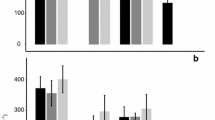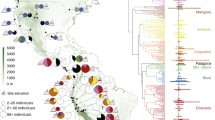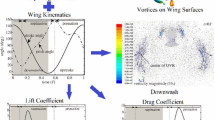Abstract
OXYGEN consumption1 and muscle power output2 of hovering hummingbirds are among the highest recorded for vertebrates. Maximum performance of hummingbirds thus approaches the upper limits of vertebrate aerobic locomotion3. Because air density is a major determinant of aerodynamic power requirements4, hovering flight performances5 can be manipulated non-invasively using nor-moxic gas mixtures of variable density6. Here we show that limits to the locomotor capacity of hovering ruby-throated hummingbirds are unequivocally indicated by aerodynamic failure at low densities less than half that of sea-level air. Hummingbirds demonstrate considerable power reserves, with muscle mass-specific power (assuming perfect elastic energy storage) averaging from 98 W kg-1 in normal air to a maximum value of 133 W kg-1 before aerodynamic failure. In contrast to such variable power expenditure, however, muscle efficiency remains approximately constant at 10%. Modulation of power output is attained primarily through variation in wing-stroke amplitude, with aerodynamic failure occurring near 180°.
Similar content being viewed by others
References
Suarez, R. K. Experientia 48, 565–570 (1992).
Wells, D. J. J. exp. Biol. 178, 39–57 (1993).
Hochachka, P. W. Muscles as Molecular and Metabolic Machines (CRC, Boca Raton, FL, 1994).
Norberg, U. M. Vertebrate Flight (Springer, New York, 1990).
Weis-Fogh, T. J. exp. Biol. 56, 79–104 (1972).
Dudley, R. J. exp. Biol. 198, 1065–1070 (1995).
Ellington, C. P. Phil. Trans. R. Soc. Lond. B 305, 145–181 (1984).
Berger, M. J. Ornithol. 115, 273–288 (1974).
Wells, D. J. J. exp. Biol. 178, 59–70 (1993).
Dial, K. P. & Biewener, A. A. J. exp. Biol. 176, 31–54 (1993).
Stevenson, R. D. & Josephson, R. K. J. exp. Biol. 149, 61–78 (1990).
Josephson, R. K. A. Rev. Physiol. 55, 527–546 (1993).
Suarez, R. K., Lighton, J. R. B., Brown, G. S. & Mathieu-Costello, O. Proc. natn. Acad. Sci. U.SA 88, 4870–4873 (1991).
Greenewalt, C. H. Smithson. misc. Collns 144, 1–46 (1962).
Brobeck, J. R. & DuBois, A. B. in Medical Physiology Vol. 2 (ed. Mountcastle, V. B.) 1351–1365 (Mosby, St Louis. MO, 1980).
Suarez, R. K. et al. Proc. natn. Acad. Sci. U.S.A. 87, 9207–9210 (1990).
Lasiewski, R. C. Physiol. Zool. 36, 122–140 (1963).
Ellington, C. P. J. exp. Biol. 115, 293–304 (1985).
Author information
Authors and Affiliations
Rights and permissions
About this article
Cite this article
Chai, P., Dudley, R. Limits to vertebrate locomotor energetics suggested by hummingbirds hovering in heliox. Nature 377, 722–725 (1995). https://doi.org/10.1038/377722a0
Received:
Accepted:
Issue Date:
DOI: https://doi.org/10.1038/377722a0
- Springer Nature Limited
This article is cited by
-
How aerial insectivore bats of different sizes respond to nightly temperature shifts
International Journal of Biometeorology (2022)
-
Spatial memory is as important as weapon and body size for territorial ownership in a lekking hummingbird
Scientific Reports (2018)
-
The biomechanical origin of extreme wing allometry in hummingbirds
Nature Communications (2017)
-
Wingbeat kinematics and energetics during weightlifting in hovering hummingbirds across an elevational gradient
Journal of Comparative Physiology B (2017)
-
Hummingbirds generate bilateral vortex loops during hovering: evidence from flow visualization
Experiments in Fluids (2013)





